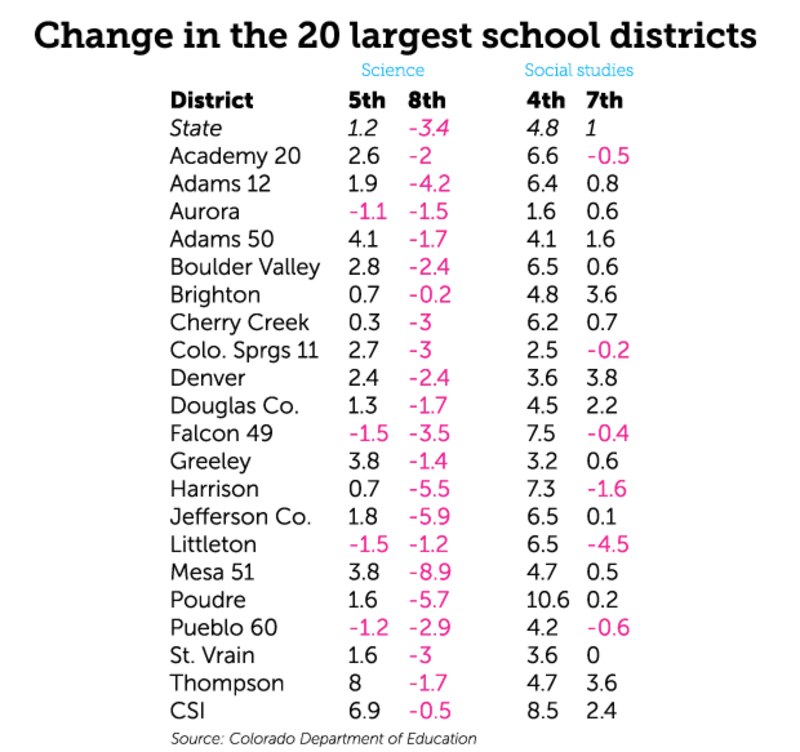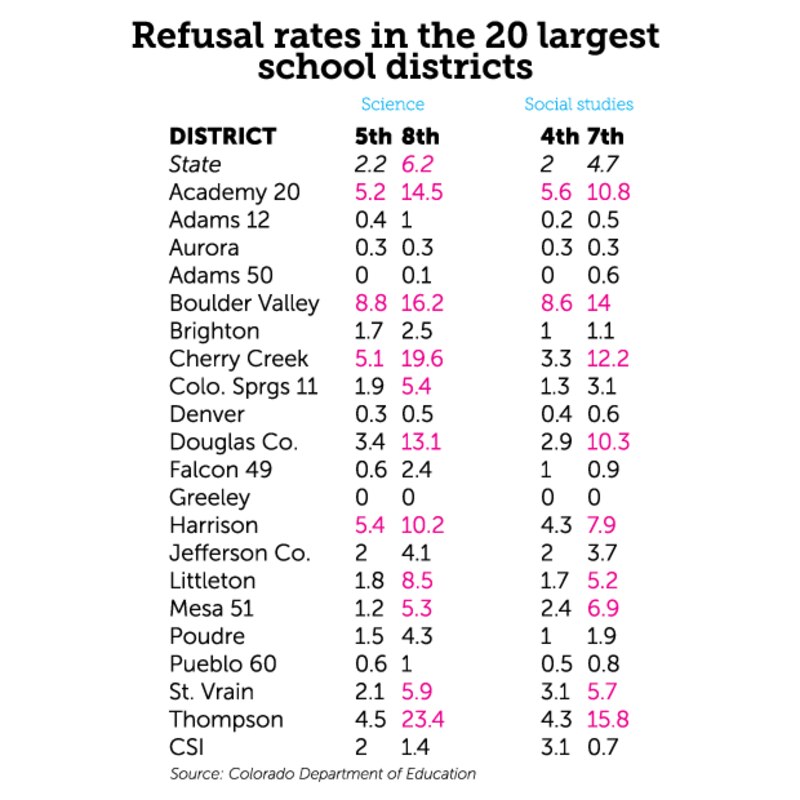Scores on statewide elementary and middle school social studies and science tests improved modestly this year compared to last year, according to results from state tests released Thursday.
The one exception was scores on the eighth grade science test, where the percentage of students meeting state expectations dropped by 3.5 points.
The percentage of students clearing the state’s proficiency bar increased by 4.8 points in fourth grade social studies, by 1 point in seventh grade social studies and by 1.2 points in fifth grade science, according to the state Department of Education.
In science, 34.8 percent of fifth graders scored high enough to be considered on track, as did 29 percent of eighth graders.
In social studies, 21.8 percent of fourth graders were labeled as having a “strong” or “distinguished” command of the subject, and 17.6 percent of seventh graders were at those levels.
The 2015 results provide the first year-to-year comparisons of student performance on the science and social studies tests. Both sets of tests were new in 2014.
“It is important to remember that this is just the second year of these tests,” said Elliott Asp, interim commissioner of education. “We expect to see future growth as teachers and students gain more experience with the standards.”
Testing opt-out rates were generally low in the elementary grades but rose in middle school. The department reported overall parent refusal rates of 2 percent for 4th grade social studies and 4.7 percent in the 7th grade. For science, the 5th grade refusal rate was 2.2 percent. The 8th grade rate was 6.2 percent.
How the tests work
The state’s CMAS testing system assesses students in the two subjects once each in elementary, middle and high school. Science tests are required by the federal government, but the social studies test is a state-only mandate. Neither test is based on the Common Core State Standards, which cover only language arts and math.
High school tests in the two subjects were given to seniors last fall. But due to action by the State Board of Education, individual student results of the 12th grade science tests will be available later this summer, but there will be no public reporting of district and school results. The board declined to set cut scores, or levels of proficiency, for the 12th grade social studies tests, so there are no results available to report.
Based on their scores, students are rated as having distinguished command, strong command, moderate command or limited command of a subject. Scoring in the top two levels is considered an indicator that a student is on track for college or a career.
Breaking down the results
Results of the tests are broken down by gender, ethnicity and other student characteristics. Historically, non-white and low-income students don’t perform as well as white and Asian students.
The department said this year’s achievement gaps were similar to those recorded in 2015.
Here are some key points from the 2015 results:
Gender – Slightly higher percentages of boys than girls scored strong or distinguished on both science tests, reversing 2014’s results. Higher percentages of girls were in the top two levels on both social studies tests.
Ethnicity – In fifth grade science, about 48 percent of white and Asian students were in the top levels, with black and Hispanic students at about 15 percent. The numbers of those students in the top levels increased from 2014. Asian students had the highest percentage in eighth grade, 45.5 percent, and percentages were below 2014 levels for all groups except Native Hawaiian/Pacific Islander. There were similar results for the social studies tests.
Poverty – The gaps between students eligible for free- and reduced-price lunch and others ranged from 28 to 34 percentage points in science and from 19 to 24 percentage points in social studies. The gaps were similar but slightly smaller for Title I students.
Other factors – There were similar achievement gaps for students identified as non-English proficient and limited English proficient, and for special education students.
Districts’ performance varied
The state’s 20 largest school districts plus the Charter School Institute, or CSI, generally tracked statewide results, but there were variations in percentage changes in students who scored with strong or distinguished command.
- A dozen districts plus CSI had larger increases than the statewide figure in fifth grade science.
- All districts dropped in eighth grade science.
- Fourth-grade social studies was a bright spot with all districts rising, and nine plus CSI showed greater increases than the state as a whole.
- The results weren’t so good for seventh grade social studies, with five districts declining and eight rising but still below the statewide increase of 1 percent.
The state’s 20 largest districts plus CSI enroll 685,978 students, about 77 percent of the 889,006 pupils in the state. The institute oversees 34 charter schools that aren’t authorized by districts.
The chart below shows the percentage point change in the percentages of students showing strong or distinguished command on the four tests. For example, 33.6 percent of state students were at those levels in fifth grade science in 2014. This year the figure was 34.8 percent, a percentage point change of 1.2.

Opting out rates varied
Some districts were hit by a wave of test refusals by high school seniors last fall. The statewide participation rate for the high school science was 81.8 percent and 81.7 percent for the social studies equivalent.
Test refusal wasn’t quite as strong during spring testing in the four lower grades, but it was noticeable. CDE reported statewide participation rates of 96.8 percent on 4th grade social studies tests and 93 percent in 7th grade.
For science, the participation rate was 96.5 percent in the 5th grade but dropped to 90.8 percent on 8th grade exams.
The department said the parent refusal rate was 2 percent for social studies and 2.2 percent for science. Students can be listed as non-participating for other reasons in addition to parent refusal.
Participation rates are a touchy issue because the federal government requires 95 percent participation or higher on statewide tests. In Colorado districts and schools can be knocked down one level in their state ratings if test taking falls below 95 percent on two or more exams.
But the state’s accountability system is in a one-year timeout because of a law passed by the 2015 legislature. So, according to the department, “participation rates on the 2014-15 assessments will not impact any state school or district accountability rating in 2015.”
The lowest opt-out rate statewide was in 4th grade social studies; the highest was in 8th grade science.
The Thompson, Boulder Valley Cherry Creek and Academy districts generally had the highest refusal rates, while the lowest were recorded in Greeley (reporting no opt outs), Adams 50, Aurora and Denver.

What’s next
The full picture of 2015 Colorado testing will become clearer later this year when CDE releases results from last spring’s language arts and math tests, known as PARCC. Those were given in grades 3-11.
This was the first year for those brand-new computer-based tests, so results won’t be comparable to the 2014 TCAP exams in those subjects. Still, the state faces a potential public relations challenge because it’s expected that the percentages of students scoring in the top levels on PARCC will be lower than the percentages in the top two classifications of TCAP.
Changes are also coming next year in science and social studies testing.
Another testing bill passed last spring requires social studies exams to be given in only a third of schools each year, ending the testing of all 4th and 7th graders.
Science tests will remain the same in elementary and middle school. But because the legislature banned statewide testing in the senior year of high school, the department will have to find a different year for that science test. It’s expected it will moved to spring of the junior year.
Starting next year 11th graders won’t have to take the PARCC language arts and math tests.
See this Chalkbeat Colorado story for a full review of 2016 testing changes. And read this article for an explanation of the role the federal government will play in those changes.


